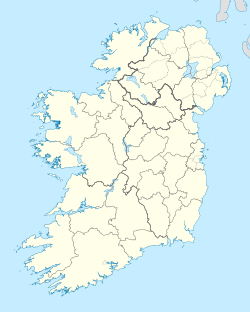Irish: Uisneach; Cnoc Uisnigh | |
 Information sign | |
| Alternative name | Ushnagh (anglicisation) |
|---|---|
| Location | County Westmeath, Ireland |
| Coordinates | 53°29′24″N 7°33′43″W / 53.490°N 7.562°W |
| Type | Ancient ceremonial site |
| Height | 182 metres (597 ft) |
| History | |
| Periods | Iron Age–Middle Ages |
| Cultures | Gaelic |
| Site notes | |
| Public access | Yes |
| Official name | Ushnagh Hill, Catstone |
| Reference no. | 155 |
The Hill of Uisneach or Ushnagh (Irish: Uisneach or Cnoc Uisnigh)[1] is a hill and ancient ceremonial site in the barony of Rathconrath in County Westmeath, Ireland. It is a protected national monument.[2] It consists of numerous monuments and earthworks—prehistoric and medieval—including a probable megalithic tomb, burial mounds, enclosures, standing stones, holy wells and a medieval road. Uisneach is near the geographical centre of Ireland, and in Irish mythology it is deemed to be the symbolic and sacred centre of the island.[3] It was said to be the burial place of the mythical Tuatha Dé Danann, and a place of assembly associated with the druids and the festival of Bealtaine.[4]
The summit is 182 metres (597 ft) above sea level[5] and lies north of the R390 road, 8 km east of the village of Ballymore and beside the village of Loughnavalley. The hill occupies parts of four adjacent townlands: Ushnagh Hill, Mweelra, Rathnew, and Kellybrook.[5]
- ^ Irish Placenames Database Archived 3 June 2012 at the Wayback Machine Retrieved 5 August 2010.
- ^ National Monuments in State care Archived 20 February 2010 at the Wayback Machine, National Monuments Service, archaeology.ie. Retrieved 5 August 2010.
- ^ Alwyn Rees and Brinley Rees. Celtic Heritage. Thames and Hudson: New York, 1961. ISBN 0-500-27039-2. pp. 159-161.
- ^ Cite error: The named reference
Schot 39-46was invoked but never defined (see the help page). - ^ a b Ordnance Survey map Archived 29 August 2012 at the Wayback Machine. Select Wind Report option for contour map. Select Historic 6" option for townland boundaries. Retrieved 5 August 2010.
